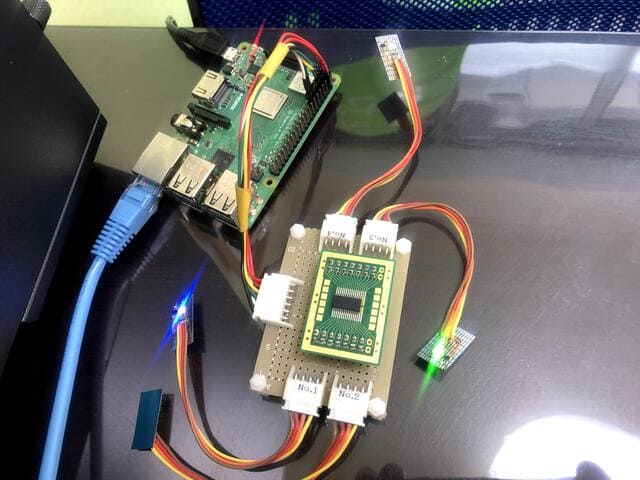2024-09-27


ラズベリーパイの用途で定番化している、LED基盤を装着し光らせる(いわゆるLチカ)のメモ。
今回利用したLED基盤はこちら。制御ボードY59116Fに4つのLEDランプが装着されている。
https://www.tij.co.jp/product/jp/TLC59116F
2本の赤コードをマイクロSD側のGPIO末端(矢印のついているほうはHDMI側)にそれぞれ刺し、その後ろに残る5本の端子を、緑を先頭に刺す。

今回使用したRaspberry PIは3B+、Raspberry Pi OS Lite 2021-05-07版。
GPIOを介したI2C制御信号で制御するので、raspi-configでI2Cを有効にする。
sudo -s raspi-config Advanced Settings -> P5 I2C を Enebledにする。 再起動
必要なソフトウェアのインストール
sudo -s apt install i2c-tools libi2c-dev python3-rpi.gpio python3-dev python3-pip pip install smbus
I2C-LED基盤を認識しているかチェック
sudo -s
i2cdetect -y 1
0 1 2 3 4 5 6 7 8 9 a b c d e f
00: -- -- -- -- -- -- -- -- -- -- -- -- --
10: -- -- -- -- -- -- -- -- -- -- -- -- -- -- -- --
20: -- -- -- -- -- -- -- -- -- -- -- -- -- -- -- --
30: -- -- -- -- -- -- -- -- -- -- -- -- -- -- -- --
40: -- -- -- -- -- -- -- -- -- -- -- -- -- -- -- --
50: -- -- -- -- -- -- -- -- -- -- -- -- -- -- -- --
60: 60 -- -- -- -- -- -- -- 68 -- -- 6b -- -- -- --
70: -- -- -- -- -- -- -- --
0x60番が存在していればOK。この60番にI2Cコマンドを送ることで、LEDがついたり消えたりする。
最初はSleep状態なので、以下初期化コマンドを送信してWake UPさせる。
i2cset -y 1 0x60 0x00 0x00
各ランプのON/OFF
0x14がLED1、0x17がLED4。これに0xFFを書き込むとランプON(=輝度が設定されていれば光る)、0X00を書き込むとランプOFF。
i2cset -y 1 0x60 0x14 0xff #led 1 on i2cset -y 1 0x60 0x15 0xff #led 2 on i2cset -y 1 0x60 0x16 0xff #led 3 on i2cset -y 1 0x60 0x17 0xff #led 4 on
各ランプの輝度の設定
上記で各ランプをONしても、輝度を設定していないとゼロ(未点灯)なので、輝度を自由に設定する。
紛らわしいのは、RGBの並びではなく、BRGの並びであるということ。0x02がLED1のB(ブルー)ランプ、0x10がLED4のG(グリーン)ランプ。全12の輝度設定。(RGB×LED4個=12)。
0x00で輝度ゼロ(消灯)、0xFFで輝度マックス。マックスは目がやられるレベルで眩しいので注意。
i2cset -y 1 0x60 0x02 0xff #led 1 B 輝度MAX i2cset -y 1 0x60 0x03 0xff #led 1 R 輝度MAX i2cset -y 1 0x60 0x04 0xff #led 1 G 輝度MAX i2cset -y 1 0x60 0x06 0xff #led 2 B 輝度MAX i2cset -y 1 0x60 0x07 0xff #led 2 R 輝度MAX i2cset -y 1 0x60 0x08 0xff #led 2 G 輝度MAX i2cset -y 1 0x60 0x0a 0xff #led 3 B 輝度MAX i2cset -y 1 0x60 0x0b 0xff #led 3 R 輝度MAX i2cset -y 1 0x60 0x0c 0xff #led 3 G 輝度MAX i2cset -y 1 0x60 0x0e 0xff #led 4 B 輝度MAX i2cset -y 1 0x60 0x0f 0xff #led 4 R 輝度MAX i2cset -y 1 0x60 0x10 0xff #led 4 G 輝度MAX
点滅させるには、これらコマンドを組み合わせて自動で打たせればよい。I2Cは、Pythonと、C言語のインタフェースが用意されている。まずはPythonで書いてみる。
| Python | i2c-led-blink.py | GitHub Source |
import smbus
import time
count = 0
i2c = smbus.SMBus(1)
addr = 0x60
i2c.write_byte_data(addr, 0x00, 0x00) #ALL LED INIT
i2c.write_byte_data(addr, 0x17, 0xff) #LED4 ON
while True:
if count % 2 == 0:
i2c.write_byte_data(addr, 0x0f, 0x22) #LED4-R Level 0x22
else:
i2c.write_byte_data(addr, 0x0f, 0x00) #LED4-R Level 0x00(Off)
time.sleep(1)
count = count + 1
print(count)
if count >= 10:
break
LED4のRランプを輝度0x22で光らせる・消すを1秒おきに交互に繰り返すことで、点滅を実現している。
実行結果
python3 i2c-led-blink.py 1 2 3 4 5 6 7 8 9 10
全く同じことを、C言語ライブラリを用いても行える。ファイルディスクリプタに命令を書き込むだけ。
| C/C++ | i2c-led-blink.c | GitHub Source |
#include <stdio.h>
#include <string.h>
#include <stdlib.h>
#include <unistd.h>
#include <fcntl.h>
#include <sys/types.h>
#include <sys/stat.h>
#include <sys/ioctl.h>
#include <linux/i2c-dev.h>
int main(int argc, char **argv) {
int fd, i; unsigned char reg,arg[2];
if( (fd = open("/dev/i2c-1", O_RDWR )) < 0) {
fprintf(stderr, "Faild to open /dev/i2c-1 as fd\n");
return (-1);
}
reg = 0x60;
if(ioctl(fd, I2C_SLAVE, reg) < 0) {
fprintf(stderr, "Unable to get bus access to talk to slave 0x%02X\n", reg);
close(fd);
return (-1);
}
arg[0] = 0x00;
arg[1] = 0x00;
if(write(fd, arg, 2) != 2) { /* ALL LED INIT */
fprintf(stderr, "Error writing to i2c slave %02x %02x\n", arg[0], arg[1]);
close(fd);
return (-1);
}
arg[0] = 0x17;
arg[1] = 0xff;
if(write(fd, arg, 2) != 2) { /* LED4 ON */
fprintf(stderr, "Error writing to i2c slave %02x %02x\n", arg[0], arg[1]);
close(fd);
return (-1);
}
for(i = 0; i < 10; i++) {
arg[0] = 0x0f;
if(i % 2 == 0) {
arg[1] = 0x22; /* LED4-R Level 0x22 */
}
else {
arg[1] = 0x00; /* LED4-R Level 0x00(Off) */
}
if(write(fd, arg, 2) != 2) {
fprintf(stderr, "Error writing to i2c slave %02x %02x\n", arg[0], arg[1]);
close(fd);
return (-1);
}
fprintf(stdout, "%d\n", i + 1);
sleep(1);
}
close(fd);
return 0;
}
コンパイル、実行
gcc i2c-led-blink.c ./a.out 1 2 3 4 5 6 7 8 9 10
※本記事内容の無断転載を禁じます。
ご連絡は以下アドレスまでお願いします★
Wav2Lipのオープンソース版を改造して外部から呼べるAPI化する
Wav2Lipのオープンソース版で静止画の口元のみを動かして喋らせる
【iOS】アプリアイコン・ロゴ画像の作成・設定方法
オープンソースリップシンクエンジンSadTalkerをAPI化してアプリから呼ぶ【2】
オープンソースリップシンクエンジンSadTalkerをAPI化してアプリから呼ぶ【1】
【Xcode】iPhone is not available because it is unpairedの対処法
【Let's Encrypt】Failed authorization procedure 503の対処法
【Debian】古いバージョンでapt updateしたら404 not foundでエラーになる場合
ファイアウォール内部のWindows11 PCにmacOS Sequoiaからリモートデスクトップする
進研ゼミチャレンジタッチをAndroid端末化する
Windows11+WSL2でUbuntuを使う【2】ブリッジ接続+固定IPの設定
Windows11のコマンドプロンプトでテキストをコピーする
【Apache】サーバーに同時接続可能なクライアント数を調整する
VirtualBoxの仮想マシンをWindows起動時に自動起動し終了時に自動サスペンドする
WindowsにSubversionをインストールしてGit Bashから使う
タスクスケジューラで変更を適用できません。ユーザーアカウントが不明であるか、パスワードが正しくないか、またはユーザーアカウントにタスクを変更する許可がありません。と出た
apt upgradeしたあとnvidia-smiがダメになった場合
size_tとssize_tを使い分けてSegmentation Faultを予防する